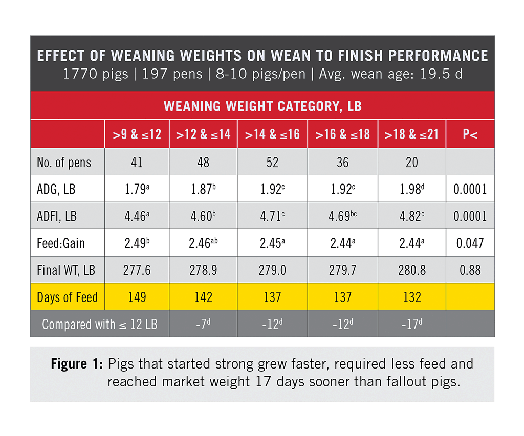New research shows that results at weaning are the ultimate predictor of lifetime performance.
December 4, 2015

In the wean-to-finish game, more pounds at the finish line is the ultimate payoff. Heavy, efficiently gaining pigs are a boost to the bottom line. But this finishing success does not happen overnight. New research shows that results at weaning are the ultimate predictor of lifetime performance — with end-of-nursery weight providing a roadmap for future productivity.
Brenda de Rodas, Ph.D., director of swine research at the Purina Animal Nutrition Center in Gray Summit, Mo., recently worked with her team to determine the impact of a strong start and weaning transition. The team at the research farm monitored individual performance in an 880-head wean-to-finish facility to determine which pigs performed the best.
“We’ve seen it firsthand in our facility: The pigs that do well at weaning are the pigs that most often grow the best through finishing,” says de Rodas. “Over the past 18 months, we have worked to measure these results. The research results confirm that stronger, heavier pigs at weaning are better able to reach their full potential more quickly and efficiently than lighter-weaned pigs. A pig’s success at the start carries through each phase to finishing.”
Start strong, finish faster
In the study, weights were documented from wean to finish, with recordings made at each diet change in the nursery and grow-finish periods. The study indicates a direct correlation between weaning weight and days required to finish at approximately 280 pounds.
“As shown in Figure 1 [see above], pigs weighing between 18 and 21 pounds at weaning had greater daily gains and improved feed efficiency from weaning to market — helping them reach market weight 17 days sooner than those with weaning weights between 9 and 12 pounds,” de Rodas states.
Further, as compared to pigs weighing less than 12 pounds at weaning, pigs weighing 18 pounds or more had the following performance improvements from wean to finish:
0.19 pound higher average daily gains
0.36 pound greater average daily feed intake
0.05 pound less feed required per pound of gain
3.2 pounds higher finishing weights
Industry research builds on these findings, demonstrating how the advantage of a strong start continues post-weaning. In a study conducted by Pollmann, et al., pigs that gained more than 0.25 pound per day in the first week post-weaning reached market weight 15 days sooner than those that did not gain weight the first week post-weaning.
“These studies confirm the importance of a solid start,” de Rodas says. “Any assistance we can give to pigs preweaning and through the weaning transition period can pay off on the finishing floor.”
Giving pigs a strong start
To create eaters and help pigs stay strong through weaning and position them for finishing success, de Rodas recommends four primary nutrition pillars.
1.Feed creep feed preweaning. Offering creep feed twice daily in small amounts for three to five days preweaning can help position pigs for weaning. In a research trial, creep feeding resulted in 28% higher average daily gains and 13% higher average daily feed intake during the first week post-weaning as compared to pigs not offered creep.
“Feeding a dry feed to pigs pre-weaning helps to create eaters at weaning,” de Rodas says. “Select a creep feed that includes highly digestible and palatable ingredients.”
2. Offer gel through the transition. Dehydration is highly probable through the weaning transition; therefore, feeding gel for at least two days preweaning and for the first five days post-weaning is recommended. Gel also can help provide nutrition to pigs before they start eating dry feed.
“Gel is unique in that it has both liquid and solid components, helping pigs transition from a liquid to a solid diet,” de Rodas says. �“Because of its high palatability and nutrient base, we provide gel free-choice on mats or creep feeders during periods of stress, including weaning, disease and environmental pressures.”
3. Provide electrolytes post-weaning. Research from Varley and Stockill shows only 51% of newly weaned pigs consume water in the first 25 hours post-weaning. With the bodyweight of young, lean pigs comprised of up to 70% water, any loss of hydration can be problematic. Adding electrolytes through a water medicator for five to seven days post-weaning can help maintain hydration.
In fact, in a study evaluating the first three days post-weaning, early weaned pigs drank four times more water with electrolytes (3.748 L/pig/24h) compared to untreated tap water (836 mL/pig/24h).
4. Start with highly palatable and digestible starter feeds. Feed consumption is impacted by weaning stress. In research on pigs weighing 11.7 pounds, feed intake was less than 0.1 pound of dry feed per day in the first two days post-weaning. Feed intake increased to 0.6 pound per day by day 8.
“Feed consumption delays can be caused by the pigs’ unfamiliarity with new facilities and inability to find water and feed sources, as well as the abrupt change in diet,” says de Rodas. “The stress of transportation and commingling can cause newly weaned pigs to be less active and curious, choosing rest over eating and drinking.
“To help pigs to a fast start at weaning, offer a feed that is highly digestible and palatable, as well as clean water,” de Rodas adds. “The more consistency we can offer in the beginning, the better suited the pigs will be to start strong — and finish stronger.”
You May Also Like



